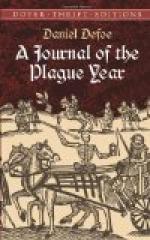This, indeed, I had in the main only from the relation of others, for I seldom walked into the fields, except towards Bethnal Green and Hackney, or as hereafter. But when I did walk, I always saw a great many poor wanderers at a distance; but I could know little of their cases, for whether it were in the street or in the fields, if we had seen anybody coming, it was a general method to walk away; yet I believe the account is exactly true.
As this puts me upon mentioning my walking the streets and fields, I cannot omit taking notice what a desolate place the city was at that time. The great street I lived in (which is known to be one of the broadest of all the streets of London, I mean of the suburbs as well as the liberties) all the side where the butchers lived, especially without the bars, was more like a green field than a paved street, and the people generally went in the middle with the horses and carts. It is true that the farthest end towards Whitechappel Church was not all paved, but even the part that was paved was full of grass also; but this need not seem strange, since the great streets within the city, such as Leadenhall Street, Bishopsgate Street, Cornhill, and even the Exchange itself, had grass growing in them in several places; neither cart or coach were seen in the streets from morning to evening, except some country carts to bring roots and beans, or peas, hay, and straw, to the market, and those but very few compared to what was usual. As for coaches, they were scarce used but to carry sick people to the pest-house, and to other hospitals, and some few to carry physicians to such places as they thought fit to venture to visit; for really coaches were dangerous things, and people did not care to venture into them, because they did not know who might have been carried in them last, and sick, infected people were, as I have said, ordinarily carried in them to the pest-houses, and sometimes people expired in them as they went along.
It is true, when the infection came to such a height as I have now mentioned, there were very few physicians which cared to stir abroad to sick houses, and very many of the most eminent of the faculty were dead, as well as the surgeons also; for now it was indeed a dismal time, and for about a month together, not taking any notice of the bills of mortality, I believe there did not die less than 1500 or 1700 a day, one day with another.
One of the worst days we had in the whole time, as I thought, was in the beginning of September, when, indeed, good people began to think that God was resolved to make a full end of the people in this miserable city. This was at that time when the plague was fully come into the eastern parishes. The parish of Aldgate, if I may give my opinion, buried above a thousand a week for two weeks, though the bills did not say so many;—but it surrounded me at so dismal a rate that there was not a house in twenty uninfected in the Minories, in Houndsditch, and in




